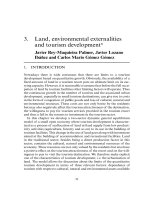THE ECONOMICS OF MONEY,BANKING, AND FINANCIAL MARKETS 453
Bạn đang xem bản rút gọn của tài liệu. Xem và tải ngay bản đầy đủ của tài liệu tại đây (47.06 KB, 1 trang )
CHAPTER 16
The Money Supply Process
421
Recall that in Chapter 13, the primary benefit to a bank of holding reserves is
that they provide insurance against losses due to deposit outflows; that is, they
enable the bank experiencing deposit outflows to escape the costs of calling in
loans, selling securities, borrowing from the Bank of Canada or other corporations,
or bank failure. If banks fear that deposit outflows are likely to increase (that is, if
expected deposit outflows increase), they will want more insurance against this
possibility and desired reserves will increase.
Changes in
Currency
Holdings
As shown before, chequable deposits undergo multiple expansions while currency
does not. Hence, when chequable deposits are converted into currency, holding
the monetary base and other variables constant, there is a switch from a component of the money supply that undergoes multiple expansion to one that does not.
The overall level of multiple expansion declines and the money supply falls. On
the other hand, if currency holdings fall there is a switch into chequable deposits,
which undergo multiple deposit expansion, so the money supply rises. This analysis suggests the following result: The money supply is negatively related to
currency holdings.
OVE RVI E W O F T HE M O NE Y SUP P LY P ROCE SS
We now have a model of the money supply process in which all three of the players the Bank of Canada, depositors, and banks directly influence the money
supply. As a study aid, Table 16-2 charts the money supply response to the three
factors discussed above and gives a brief synopsis of the reasoning behind them.
The variables are grouped by the player or players who are the primary influence behind the variable. The Bank of Canada, for example, influences the money
supply by controlling the first two variables (called tools of the Bank of Canada).
Depositors influence the money supply through their decisions about their holdings of currency, while banks influence the money supply by their decisions about
desired reserves. However, because depositors behaviour influences bankers
expectations about deposit outflows, which as we have seen affects banks decisions to hold reserves, depositors are also listed as a player determining desired
reserves.
TA B L E 16 - 2
Money Supply Response
Change in
Variable
Money Supply
Response
Nonborrowed
monetary base, MBn
*
*
More MB for deposit
creation
Borrowed
reserves, BR
*
*
More MB for deposit
creation
Depositors
Currency holdings
*
+
Less multiple deposit
expansion
Depositors and
banks
Desired reserves
*
+
Less loans and deposit
creation
Player
Variable
Bank of Canada
Reason
Note: Only increases (*) in the variables are shown. The effects of decreases on the money supply would be the
opposite of those indicated in the Response column.









